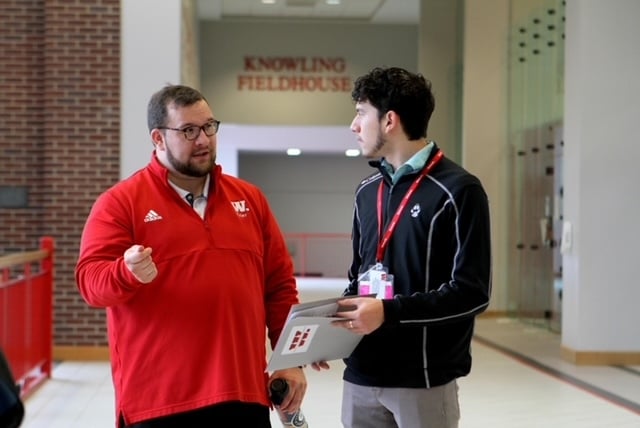You have /5 articles left.
Sign up for a free account or log in.

Tyler Wade (left), a Dallas-based regional recruiter for Wabash College, speaking on the Indiana campus with a student he recruited from Texas.
Tyler Wade
Marist College is probably the second best-known private higher education institution in Poughkeepsie, N.Y., the post-industrial city a few hours north of the Big Apple that is also home to the liberal arts darling Vassar College.
And yet Marist recruiter Angie Alamah is not visiting high schools up and down the Hudson River or even in Connecticut and New Jersey; she lives and works hundreds of miles away in Dallas.
Marist hired Alamah last year as its first recruiter in Texas, but she has been working as a nonresident recruiter in the state for eight years, largely for institutions based in the Midwest and Northeast. She said the number of recruiters in the region has doubled since she started her current career path. And interest from local families has surged as the idea of going to a faraway college becomes more commonplace.
“A few years ago, my job was much harder. I worked for a school in Chicago, and to the students here it may as well have been Switzerland,” Alamah said. “It’s not as hard of a sell now, and counselors are much more eager to work with us.”
An increasingly diverse array of institutions is sending counselors far afield to woo applicants. Michael Harris, a professor of higher education at Southern Methodist University who co-wrote a 2016 paper on the expansion of nonresident recruitment, said much of that growth has followed demographic trends. As college-age populations in the upper Midwest and Northeast decline, more enrollment-hungry institutions are sending recruiters to the West Coast and deep South.
Harris said the practice has expanded from highly selective privates to state flagships with funding challenges, and it has ballooned in recent years to include regional public campuses and small, little-known private colleges.
“Historically this was a tactic used only by the most prestigious universities. But as enrollments got tighter, finances got tighter, state funding started to dry up, you saw more institutions in that next proverbial tier down—liberal arts colleges and, most notably, state flagships—start doing it,” he said. “This strategy trickled down throughout the higher education sector, to the point now where I would imagine most four-year institutions are using it to at least some degree.”
Tyler Wade, a recruiter and admissions counselor for Wabash College in Indiana who is based in Dallas with Alamah, said he’s seen a boom in recruiters from far-flung colleges in the four years he’s been on the job.
“There are more recruiters every year from new institutions, and those that were here before are doubling and tripling down,” he said. “It’s getting much more competitive.”
For colleges looking to compensate for the Supreme Court’s affirmative action ban, it doesn’t hurt that most of the growth in these regions is among nonwhite populations.
“Diversity is a big part of the draw for a lot of colleges here,” Wade said. The Supreme Court decision “has made our jobs a lot more important, especially in Texas.”
Harris said he doesn’t see the nonresident recruitment train slowing down anytime soon.
“This was a strategy adopted by a fairly small number of institutions 25 to 30 years ago, and now it’s pretty much accepted, standard practice,” he said. “In 10 years, to not have any sort of strategic regional recruiting strategy will probably be malpractice.”
From Flagships to Regionals
The University of Alabama was among the first to make a nonresident recruitment push more than a decade ago, Harris said. The flagship in Tuscaloosa took advantage of the lack of state regulation to build a far-reaching recruitment operation unrivaled by other public universities.
“It really started with Alabama and then spread throughout the [NCAA Southeastern Conference], where these public universities in red states often had less state funding or were experiencing heavy cuts in the early 2000s,” Harris said.
Other public systems have begun to catch up recently, including the University of Maine, where the much-feared demographic cliff has already arrived; the University of Pittsburgh, which for years has faced cuts and underfunding from the Pennsylvania Legislature in addition to severe demographic woes; and the University of Colorado at Boulder, where the out-of-state population is currently straining against state-imposed limits.
A handful of state legislatures have worked to limit nonresident recruitment in the interest of preserving space for state residents. The North Carolina Legislature, for instance, has mandated caps on out-of-state students in the University of North Carolina system. But that hasn’t stopped some campuses from going after tuition-paying out-of-state students anyway; UNC Wilmington was fined $4 million earlier this month for exceeding the cap.
As enrollment troubles worsen, the appeal of nonresident recruitment has spread far beyond the flagships.
The University of Alabama at Birmingham hired Jeffrey Jost earlier this year to recruit in the Carolinas. He said many of his counterparts in Charlotte, where he’s based, are from well-known private colleges or, more frequently, large public flagships—including two from his system’s flagship in Tuscaloosa. But with each year, more recruiters arrive from regional public colleges and small private institutions with religious affiliations or niche specialties, who simply can’t fill their seats by recruiting in surrounding counties anymore.
“There aren’t enough high school graduates in Alabama, and [of] those that are, not a lot are actually going to college,” he said; only 54 percent of graduating high schoolers in the state attend college, according to a 2021 study from the Public Affairs Research Council of Alabama. “Colleges that are really in need of more tuition revenue are finding that regional recruiters pay for themselves very quickly, not only in new students but also in reduced travel costs for campus counselors.”
While technically an admissions counselor, Jost said he does not typically read applications, even from the students in his region. Some regional recruiters, like Alamah and Wade, also read applications, but Jost said his role was more akin to a “brand ambassador.” And working for a regional public, Jost said his pitch to students has to be unique.
Since his institution lacks SEC football and the vibrant Greek life of the Tuscaloosa flagship, Jost advertises specific programs like UAB’s premed track. The University of Alabama system’s lower cost and generous out-of-state scholarships sometimes help sweeten the deal for Carolinians considering a regional UNC system campus.
Some critics have bristled at the rise in nonresident recruitment, especially for public universities whose mission is to serve local families and economies. Research has shown out-of-state recruiters tend to focus on wealthier ZIP codes, where students can pay full tuition—and where, even in more diverse regions, the student bodies tend to be majority white.
“They’d still likely overlook poorer areas, especially rural ones where there are less students. That’s where I’m critical of this strategy, and that disparity is only going to become a bigger deal in the next few years,” Harris said. “Even then, I understand the dilemma. If they recruited underrepresented students in other states, would they be able to serve their local low-income and nonwhite populations as well?”
Courtesy of Angie Alamah
Competition and Community
Jost worked as a high school admission counselor in Charlotte for years before taking the new job with UAB, so he has a built-in network to start with. But even with that head start, nonresident recruitment is a long-term investment for lesser-known institutions.
“It takes a good two or three years to really build those relationships on the ground,” he said. “I think every institution that can should have regional recruiters on the ground. But they have to understand it’s a commitment.”
The challenge of laying that groundwork can be overwhelming, especially for the many recruiters who are the first to hold their position in a given region. A growing bunch of professional networks and affinity organizations is helping them find their way forward; there are currently 27 regional recruiter networks, from Oregon to Tennessee to New England, according to the National Association of Regional Admission Counselors.
“Pooling resources can be really helpful,” said Jost, who belongs to the Charlotte Regionals of West North Carolina, or CROWN.
One of the largest regional recruiter organizations is the Dallas–Fort Worth Area Recruiters Network, or DARN, which boasts nearly 50 individual recruiters as members. The region has one of the fastest-growing college-age populations in the country, buoyed by transplants from the Midwest and Northeast as well as by a decade of demographic shifts that are making the area younger and less white.
“There’s way more competition now,” Alamah said. “I have to work a lot harder to stand out at college fairs.”
But that sense of competition hasn’t led to any acrimony between the recruiters themselves, Alamah said; if anything, it’s had the opposite effect.
Wade and Alamah, both DARN members, are technically direct competitors, working to entice Texas high schoolers to apply to small liberal arts institutions with limited national name recognition. And yet they are the closest each other has to day-to-day colleagues, and they cherish the professional connection that DARN has given them.
“I don’t have an office, and I love my campus colleagues, but I see them only a few times a year,” Alamah said, on a Zoom call a few inches from Wade, who nodded in agreement. “These are my co-workers. And I’m so grateful for that.”









